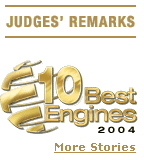
 |
Retired auto technician Pete Wright had been working on rotary engines for a few years when, in 1978, Mazda Motor Corp. put one in its new RX-7 sports car. Soon Wright was fixing a lot of clutches.
“People were burning them out right and left, pushing their RX-7s,” he recalls. “One owner blew out three clutches in a year. It was a hot car.”
The RX-7 ended its North American run in 1995, and its unconventional engine took a 9-year hiatus in the U.S. It returns in an all-new vehicle, the ’04 RX-8. It proves Mazda is persistent or the rotary is resilient – or both.
 | ||
| Judge Steve Finlay |
The RX-8’s engine cranks out about as much power as the previous-generation turbocharged rotary in the RX-7, but it’s 30% lighter and more compact. The RX-8 with a 6-speed manual transmission delivers 238 hp. That’s impressive for a lightweight 1.3L engine (although power peaks require high rpm levels).
You won’t find more than one rotary engine among Ward's 10 Best Engines (or any other engine list for that matter) because there’s only one: Mazda’s.
But it’s noteworthy. Not only does the new one squeeze out the juice, it does so smoothly and quietly due to the nature of its two spinning, triangular trochoids, rather than the action of pumping pistons. “It’s a pretty simple engine, and that’s the beauty of it,” says Wright.
A German, Felix Wankel, invented the rotary, a.k.a. the Wankel. NSU, a precursor to today’s Audi AG, was first to introduce a rotary-powered production vehicle in 1958. Only Mazda stuck with it.
It was a hit when Mazda first introduced it in the RX-3 compact in 1967.
“The public loved it, and it initially sold well,” says industry veteran David C. Smith, former editor-in-chief of Ward's AutoWorld and founder of the Ward's Wankel Report, a newsletter that evolved into today’s Ward's Engine and Vehicle Technology Update. “There were 30 rotary engine licensees around the world. There was talk of all sorts of applications, from helicopters to lawn mowers.”
General Motors Corp. planned to put Wankels in various vehicles. But for all its advantages, the engine got so-so fuel economy (and still does). Emissions issues and the fuel crisis of the mid-1970s scared off GM. After that, rotary engines fell short of their predicted popularity.
Several auto makers experimented with rotary engines over the years. Conspicuously absent was Ford Motor Co. Late Chairman Henry Ford II said the concept was dumb.
Today, Ford owns controlling interest in Mazda Motor Corp., keeper of the rotary. Its U.S. return wouldn’t have occurred without Ford approval.




